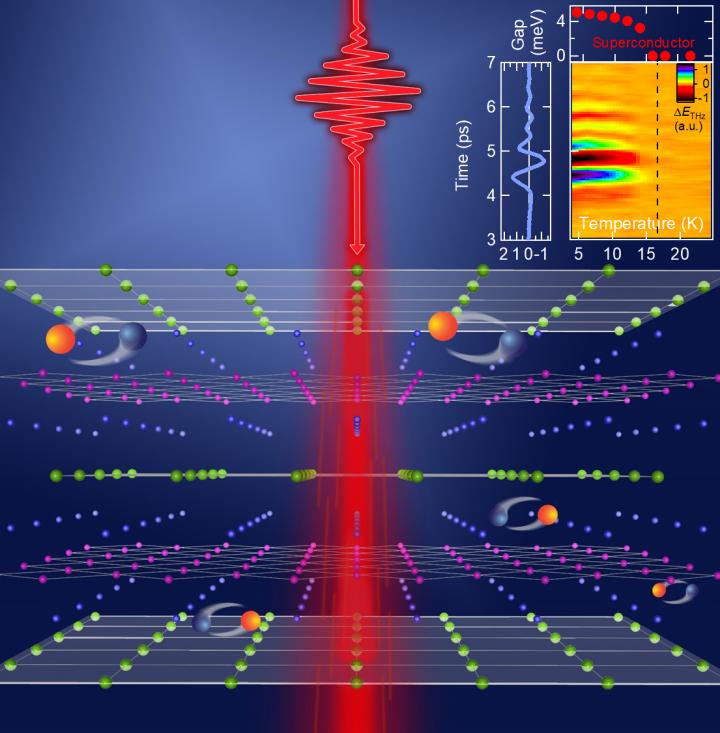Physicists uncover new competing state of matter in superconducting material

Ames Laboratory researchers used laser pulses of less than a trillionth of a second in much the same way as flash photography, in order to take a series of snapshots. Called terahertz spectroscopy, this technique can be thought of as "laser strobe photography" where many quick images reveal the subtle movement of electron pairings inside the materials using long wavelength far-infrared light. Credit: US Department of Energy, Ames Laboratory
“Superconductivity is a strange state of matter, in which the pairing of electrons makes them move faster,” said Jigang Wang, Ames Laboratory physicist and Iowa State University professor.
“One of the big problems we are trying to solve is how different states in a material compete for those electrons, and how to balance competition and cooperation to increase temperature at which a superconducting state emerges.”
To get a closer look, Wang and his team used laser pulses of less than a trillionth of a second in much the same way as flash photography, in order to take a series of snapshots.
Called terahertz spectroscopy, this technique can be thought of as “laser strobe photography” where many quick images reveal the subtle movement of electron pairings inside the materials using long wavelength far-infrared light.
“The ability to see these real time dynamics and fluctuations is a way to understanding them better, so that we can create better superconducting electronics and energy-efficient devices,” said Wang.
###
The research is further discussed in a paper, “Non-equilibrium Pair Breaking in Ba(Fe1-xCox)2As2 Superconductors: Evidence for Formation of Photo-Induced Excitonic State,” authored by X. Yang, L. Luo, M. Mootz, A. Patz, S. L. Bud'ko, P. C. Canfield, I. E. Perakis, and J. Wang; and published in Physical Review Letters.
Ames Laboratory scientist and ISU professor Paul Canfield, expert in the design and characterization of iron pnictides, created the single crystal sample used in this investigation. Martin Mootz and Ilias E. Perakis, at University of Alabama Birmingham, developed the theory to explain the observation.
Spectroscopy work was supported by the U.S. Army Research Office. Sample growth and characterization was supported the U.S. Department of Department of Energy's (DOE) Office of Science. Theory work at the University of Alabama, Birmingham was also supported by the DOE.
Ames Laboratory is a U.S. Department of Energy Office of Science national laboratory operated by Iowa State University. Ames Laboratory creates innovative materials, technologies and energy solutions. We use our expertise, unique capabilities and interdisciplinary collaborations to solve global problems.
DOE's Office of Science is the single largest supporter of basic research in the physical sciences in the United States, and is working to address some of the most pressing challenges of our time.
For more information, please visit science.energy.gov
Media Contact
All latest news from the category: Physics and Astronomy
This area deals with the fundamental laws and building blocks of nature and how they interact, the properties and the behavior of matter, and research into space and time and their structures.
innovations-report provides in-depth reports and articles on subjects such as astrophysics, laser technologies, nuclear, quantum, particle and solid-state physics, nanotechnologies, planetary research and findings (Mars, Venus) and developments related to the Hubble Telescope.
Newest articles

Silicon Carbide Innovation Alliance to drive industrial-scale semiconductor work
Known for its ability to withstand extreme environments and high voltages, silicon carbide (SiC) is a semiconducting material made up of silicon and carbon atoms arranged into crystals that is…

New SPECT/CT technique shows impressive biomarker identification
…offers increased access for prostate cancer patients. A novel SPECT/CT acquisition method can accurately detect radiopharmaceutical biodistribution in a convenient manner for prostate cancer patients, opening the door for more…

How 3D printers can give robots a soft touch
Soft skin coverings and touch sensors have emerged as a promising feature for robots that are both safer and more intuitive for human interaction, but they are expensive and difficult…





















